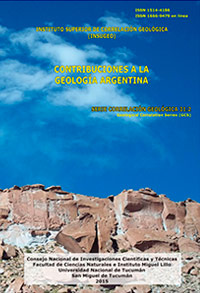Serie Correlación Geológica 31 (2)
El Complejo Punta Negra - Cerro Negro: un acontecimiento volcánico- plutónico único en el ciclo famatiniano en la zona batolitica central (La Rioja y Catamarca, Argentina)
Alejandro J. Toselli | Juana N. Rossi | Miguel Angelo Stipp Basei
Descargar trabajo en formato PDFResumen
PLUTONICO UNICO EN EL CICLO FAMATINIANO EN LA ZONA BATOLITICA CENTRAL (LA RIOJA Y CATAMARCA, ARGENTINA). En este trabajo, se avanza en la interpretación de un intrusivo volcánico - plutónico ordovícico en las Sierras Pampeanas Noroccidentales integrado por tonalitas epizonales que gradan a pórfidos dacíticos, andesíticos y riolíticos que forman un domo lávico exógeno, estando el conjunto afectado por brechamiento magmático primario y deformación tectónica posterior. Los afloramientos del domo subvolcánico-plutónico Ordovícico, se desarrollan en el sureste de la Sierra de Vinquis y en el extremo norte de la Sierra de Velasco. El complejo plutónico-volcánico de Cerro Negro, presenta contactos intrusivos con esquistos bandeados y desarrollan vetas de cuarzo con mineralización de turmalina y scheelita; estando a su vez intruido por un granito Carbonífero. Asimismo, en la Punta Negra, el complejo está intruido al este por granitos de edad carbonífera y al oeste está en contacto con granitos ordovícicos deformados. Diques tardíos de aplitas con turmalina, sin mineralización atraviesan los pórfidos. Los pórfidos son dominantemente dacíticos, localmente gradan a tonalitas y ambos están constituidos por cuarzo, plagioclasa, biotita, clorita, epidota y opacos. Geoquímicamente muestran patrones calco-alcalinos y peraluminosos. Los xenolitos pelíticos incluidos en las brechas volcánicas de Punta Negra muestran metamorfismo térmico con formación de cordierita, biotita y feldespato potásico. La geoquímica de los elementos trazas muestra afinidades con arcos de islas continentales en transición a arcos normales, semejantes a las del Sistema de Famatina. Los valores iniciales de isótopos de Sr 0,7117 a 0,7128 y εNd de –5,0 a –5,9 indicarían un origen cortical y las edades modelos obtenidas entre 1,5 y 1,6 Ga son coincidentes con las de otros granitoides famatinianos. Ambos afloramientos subvolcánicos son correlacionables entre si, en base a las similitudes petrográficas, geoquímicas e isotópicas, así como por los valores geocronológicos de 481 ± 9 Ma para Cerro Negro y 471 ± 3 Ma para Punta Negra. Estos afloramientos corresponden a las únicas manifestaciones epizonales-subvolcánicas Ordovícicas conocidas en las Sierras Pampeanas Noroccidentales.
Abstract
PUNTA NEGRA – CERRO NEGRO COMPLEX: A SINGLE VOLCANIC - PLUTONIC EVENT DURING FAMATINIAN CYCLE IN THE CENTRAL BATHOLITHIC ZONE (LA RIOJA AND CATAMARCA, ARGENTINA). This paper reports the first occurrence of Ordovician volcanic - plutonic rocks in the Northwestern Sierras Pampeanas of Argentina located at the southeast of the Sierra de Vinquis and in the northern tip of the Sierra de Velasco. They form an exogenous lava dome of medium to coarse – grained dacite, andesite and rhyolite porphyries and local breccias syn-genetically formed, affected by post-emplacement deformation. The Ordovician porphyritic Cerro Negro rocks, with tectonic deformation, show intrusive contacts with banded schists that contain quartz-tourmaline veins with scheelite mineralization, and are intruded by Carboniferous granite in the meta-vulcanites. The Ordovician meta-vulcanites of the Punta Negra, are intruded at the east by a Carboniferous granite, and to the west show tectonic contacts with deformed Ordovician granites. The porphyritic rocks are intruded by late aplitic tourmaline-bearing dikes without ore-bearing mineralization. The meta-vulcanites are composed by quartz, plagioclase, biotite, chlorite, epidote and opaques. Metapelite xenoliths included in the Punta Negra porphyry, show cordierite, biotite and potassium feldspar formed by thermal metamorphism. Geochemically the both porphyries are calc-alkaline and peraluminous. Trace elements geochemistry is similar to the compositional patterns of Continental Islands Volcanic Arc, in transition to Normal Arc, that are similar to the composition of the Famatinian vulcanism elsewhere. The initial values of isotopes of Sr 0.7117 – 0.7128 and Nd of –5.0 – 5.9, indicate a crustal origin. The Nd model ages obtained of 1.5 and 1.6 Ga are concordant with those of other Famatinian granites. Both subvolcanic outcrops are correlated on the basis of petrographic, geochemical and isotopic similarities and also by the geochronologic age of 481 ± 9 Ma in Cerro Negro, and 471 ± 3 Ma for Punta Negra, that are the only known sub-volcanic manifestations in the Northwestern Sierras Pampeanas.






